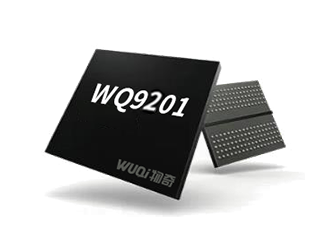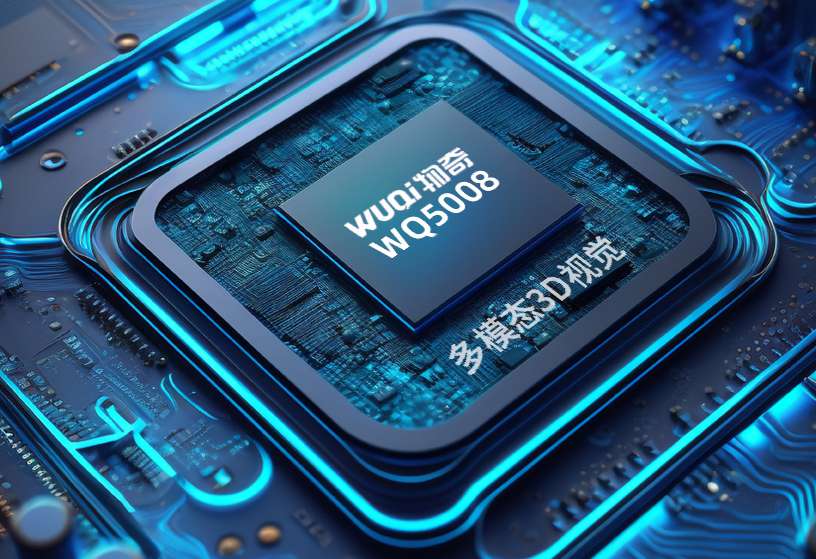China's leading fabless in short-range wireless communications Chongqing Wuqi Microelectronics Co., Ltd. (“wuqi”) announced a multimodal 3D vision processing chip: WQ5008, by utilizing a new multimodal vision technology, enable robots to be applied more intelligently in diverse scenarios.
Recent years have witnessed a spurt of progress in AI technology and biometric, mainstream 3D vision technologies are evolving from single technologies like Time of Flight (ToF), binocular vision, and structured light to fusion technologies such as binocular ToF, binocular structured light, and hybrid structured light + ToF. Singular technology evolution is transitioning to multi-technology fusion, which has largely overcome its drawbacks. Like how insects observe the world through compound eyes, the fusion of various 3D vision technologies brings about multi-modal vision perception. This capability offers new perspectives and solutions to a series of challenges in machine vision, such as environmental light interference, detection range, and detection accuracy.
Based on the rich experience of first-generation low-power 3D edge computing chip, WQ5008 has pioneered various 3D vision core operator hardening acceleration processing, achieving high throughput, a leap in edge computing power, and the integration of multiple technological solutions. It is currently the only product in the industry capable of simultaneously supporting binocular ToF, binocular structured light, and hybrid structured light + ToF.
WQ 5008 can tailor flexible solutions and customize requirements for different customers and scenarios, covering markets ranging from lightweight applications to the vast robotics. This can be widely applied in smart sweepers, humanoid robots, as well as in higher-security-level biometric identification, offering value and imagination space.
Innovating towards new domains and scenarios, WUQI’s multi-modal 3D vision processing chip, not only achieves technological advancements but also meets a broader range of market demands and product innovation directions. Building upon the first-generation chip WQ5007, it has improved the product performance to the extreme.
Built-in self-developed high-performance RISC-V multicore architecture, support enhanced computational capability upgrades and SIMD ISA improvements.
Newly self-developed ISP algo and image preprocessing modules, support image processing and arbitrary angle rotation, affine transformation, scaling, and distortion correction of images.
Further improved 3D vision hardware processing module, in addition to structured light, added TOF deep processing module, and binocular processing operator.
Support 3-channel 1080P@30fps high-resolution image acquisition, high-performance image processing, and H.264/MJPEG encoding at 1080p@30fps.
Support financial-grade security encryption engine with complete TrustZone solution, effectively preventing various side-channel attacks, providing customers with all-round data asset protection.
Self-developed secure NPU supports end-to-end decryption. User-trained neural network weight data can be stored in encrypted form in flash memory (with offline encryption tools support) or in RAM. Before entering the NPU's computational unit, pipeline hardware decryption is provided, effectively protecting user assets as well as privacy or sensitive information.
Ultra-low power consumption, dynamic power management, with power consumption metrics leading the industry, making it highly cost-effective for battery applications.
Different from single 3D vision technology, multi-technology fusion brings about multimodal 3D vision, which can effectively address issues such as accurate recognition, obstacle avoidance navigation, distance misjudgment, and parallel processing at close and medium distances in various application scenarios.The multimodal 3D vision processing chip features leading high integration, enabling smaller size and greater design flexibility; self-developed multi-channel data acquisition algorithms ensure high reliability; built-in NPU deep algo and stereo structured light technology enable high-frequency perception computing in complex environments, greatly improving recognition accuracy and distance judgment; meanwhile, strong low-power computing capabilities at the edge side; this chip can meet customer's various application demands and innovative directions to the fullest extent (such as palm vein recognition, vision intercom, motion capture, gesture recognition, and focus assist).
As an emerging force in edge computing, Wuqi focuses on two mainstream directions: 3D machine vision and local speech recognition. With leading technological advantages and mature system-level chip solutions, Wuqi has achieved significant market breakthroughs in sub-markets such as 3D vision and on-device speech interaction.
In the future, Wuqi will continue to dedicate in edge submarkets such as smart homes, intelligent transportation, and automotive electronics, driving the deep development and application of edge AI. We aim to contribute Wuqi solution to the industrial intelligence of the Internet of Everything.




















